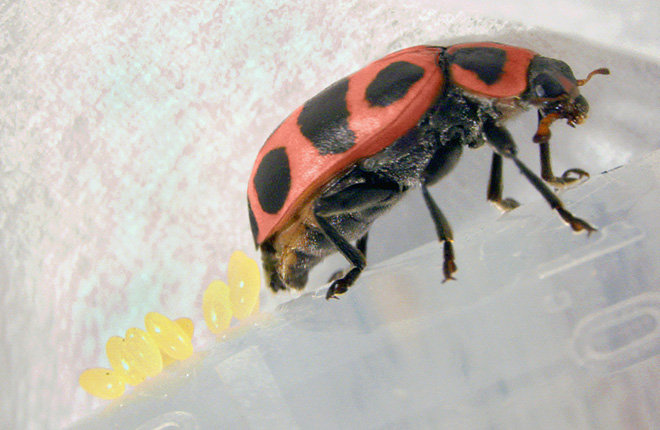Improving a Native Ladybug's Biocontrol Prospects
“Necessity is the mother of invention,” the saying goes. Such was indeed the case when entomologist Meg Allen devised a jar-like cage to safely collect the eggs of Coleomegilla maculata for her research on the genetics of this helpful ladybug species, a.k.a. pink spotted lady beetle.
Now, an Agricultural Research Service patent on Allen’s invention could open the door to a commercial-scale procedure insectaries can use to mass-produce the ladybug’s eggs for release in home gardens, commercial greenhouses, and crop fields where they would prey on the aphids, spider mites, and other plant-damaging pests lurking there.
“One of the shortcomings of lady beetles for biological control is they can fly! When they’re sold as adults, they don’t stay on the plants in your garden. If they were sold as eggs, they would hatch and the larvae would walk on the plants and eat pests before maturing,” explains Allen, with ARS’s Biological Control of Pests Research Unit in Stoneville, Mississippi.
ARS is interested in the pink spotted lady beetle because of its potential for use in biocontrol programs. Native to the United States, it’s a generalist predator that hunts for prey in many economically important crops, including wheat, corn, cotton, alfalfa, soybean, pea, and tomato, among others. Unlike the Asian spotted lady beetle (Harmonia axyridis), a nonnative competitor, the pink spotted lady beetle doesn’t invade homes during the winter and become a nuisance. It can also survive on pollen when prey is scarce, adding to its versatility as a biocontrol agent that could diminish the need for insecticides.
Prior to conducting her genetics studies, Allen searched for an easy-to-use, standardized method of collecting eggs from laboratory colonies of the ladybug. Finding none, she custom-built a system from scratch using off-the-shelf supplies.
The system comprises a squat jar and mesh-screen lid fitted with several strips where female ladybugs can deposit their eggs. In designing it, Allen considered both her need for a steady supply of eggs from which to extract DNA for genetic analysis and the ladybug’s own behavior, particularly its egg-laying preferences. For example, the beetles chose textured strips instead of smooth, waxy ones—perhaps because, in nature, females prefer plants with tiny surface hairs, called “trichomes.” Laboratory experiments (co-reported with ARS entomologist Eric Riddick in January 2012 in the journal Psyche: A Journal of Entomology) confirmed the observation. On average, females deposited 150 percent more egg masses on textured strips than on smooth ones.
Hanging the strips from the jar’s center also reduces cannibalism and ensures that the eggs can be quickly and safely removed as needed. For large-scale egg collection, Allen uses a 6-jar configuration that houses 10 to 20 female ladybugs each and enables collection of a couple hundred to a few thousand of egg masses a day.
“I hope this system will be adopted throughout insect-rearing facilities,” she says. “It can be scaled up and there are all sorts of ways it can be adjusted for different species and quantities.”—By Jan Suszkiw, Agricultural Research Service Information Staff.
“Improving a Native Ladybug’s Biocontrol Prospects” was published in the July 2015 issue of AgResearch Magazine.
Key Facts
- Pink spotted lady beetle is a potential pest biocontrol.
- Currently, there’s no easy way to raise these lady beetles.
- A patented ARS technology can solve the rearing problem.
- With the new technology, users can harvest thousands of eggs daily.
- The new system is easy to use and less messy than traditional systems.
Full Story







